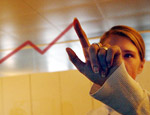The statistical services of Armenia have published the concluding annual report on the macroeconomic situation in Armenia. According to the statistical services, in the period of January-November the GDP of Armenia grew by 2.6% compared to the same period of the previous year.
The final comprehensive report concerning the 12 months of this year will be published early next year. As it is mentioned above, the GDP compared to the 11 months of the previous year grew by 2.6%. The electronic media discussed the information provided by the statistics services and reported that in November the GDP was cut down by 5.3% compared to October. It is not a very bad situation because the experience of the past years shows that November is not an economically active month. The GDP in November of 2009 was cut down by 6.4%, in 2008 – 30.6%, and in 2007 – by 17%.
It is interesting to know what was the stimulus driving the GDP to growth. The sectors of construction and agriculture have stagnated by 3.8 and 14.5% correspondingly. The production grew by 9.8%. The authorities are trying to introduce this dynamics in bright colors to show that the economy is diversified and the capacity of construction in the GDP is reducing and giving a place to production. We would like to remind the supporters of this concept the words Russian economist Abel Aghanbegian said. “Yes, the construction has not recovered and it is stagnating as before. But it is very bad. There is nothing to be proud of here. The production has really grown in 2010. But this was possible mainly due to the mining sector. i.e. the growth of the prices of metals. However this is not a domestic growth” (this was taken from an interview the 168 Hours took from Aghanbegian a couple of weeks ago).
The growth of the GDP is important only in case if the entire society can benefit from it. In order to enable the entire society enjoy the benefits of the GDP growth, there should not be polarization of the society. Thus, it would be better to evaluate this kind of growth not with economic but happiness indicators. It may sound romantic but the point is that they cannot feed the society with numbers and rates and expect that they will be happy.
The brightest example of the above is the fact that even after years of double-digit economic growth every third person is poor in this country (National Statistics Service, Armenia’s Social Picture and Poverty report 2010). Why should the Armenians be unhappy if according to the official information the salaries have grown by 7.2% only but the prices more than 9%.
There are contradictions concerning the other economic indices as well. According to the official information, the production has grown, the import, the incomes of the society have grown, but the retail trade capacity has grown by half percent only. This means that the shady sector is again dominating in the economy.
The number of unemployed people is 81,000, which is less by 2.4% compared to the same period of the previous year. We should not focus on this information because it concerns only the officially registered unemployed people. The representatives of the government admit too that the level of unemployment is much higher than the official 7%.
As for the foreign trade, they assure that the export has grown by 41.2% reaching 896 million dollars. The import growth rate is smaller and makes 14.2%, but the monetary expression of this growth is equal to 3,370 million dollars. The negative balance of the foreign trade is 2,474 million dollars. In order to compare it is worth mentioning that the negative balance of the 11 months of the previous year was 2,322 million dollars, which means that the situation with the foreign trade is not good either. Based on this information everyone can understand how the government worked in the past year, however we should not rely on the official information published by the state statistics services only.

